
Right from his childhood, Sathaye evinced a keen interest in Sanskrit, later became an ardent student of Sanskrit, tutored by some of the best sanskritists in Pune, that eventually led him to seriously engage himself in the history of Indian mathematics, delving deeper into the original Sanskrit works. An expert on the works of Brahmagupta and Bhāskara II, Sathaye provided novel explanations of their conception of khahara and khaguṇa, about which he shares his thoughts in this interview.
Sathaye is on the Advisory Council of the HoMI project, to which this special issue is dedicated.
We would like to hear from the very beginning. Can you please lead us through your early childhood, and your family background?
AS: I was born in Pune, India, on 17th January 1948. My father was Madhav, called Nana, and my mother was Yamuna, also called Nirmala, or Tai.
My mother’s family had many teachers in it, including herself, her mother, and an uncle of mine. My son Adheesh and I have extended this tradition. My maternal grandfather was a supervisor of education. Unfortunately, he passed away very early, soon after my birth.
As a young boy, I seemed to have an allergy to my father’s home. I used to contract fevers while living in that home! So, I spent my early years with my mother and an aunt, in my grandmother’s apartment. Since she was a teacher too, education was a high-priority item in our house!
The bottom half of one wall was painted black and served as a blackboard. At about four or five years of age, one of my daily chores was to write multiplication tables on it from 2 going up to 30 every day! Pretty soon, I got bored and started writing the tables one row at a time, so I only needed to add a single number many times, rather than recalling actual multiplications.
Later, our dinner conversation for many years consisted of trying to answer “word problems”. In addition, there were the traditional evening prayers in Sanskrit, coupled with memorising some verses in Sanskrit or Marathi.
As a young kid, I attended a Montessori school, and I was trained both in writing, as well as in very elementary mathematics. This prepared me to skip the first grade and start primary school from second grade. Since I was born in January, and the school admissions started in June, I only stayed in the primary school for two and a half years, instead of the usual four. Naturally, I would be the youngest in my peer group. My grandmother’s brother just took me to school one day, and asked that I be put in the second grade! Since he was a supervisor in our high school, there was no objection by anybody.
Where did your schooling happen? Any interesting incidents or episodes that have left a lasting imprint on your mind?
AS: In primary school, I don’t have specific memories to narrate. After primary school, I went to middle and high schools (from fifth to eleventh grade), run by an organisation known as “Shikshan Prasarak Mandali”–-loosely translated to refer to an `Organisation for Spreading Education’. All my schools had old-fashioned names such as “Nutan Marathi Vidyalaya”, with additional descriptors like Primary, Middle and High.
bottom half of one wall was painted black and served as a blackboard
For college, I went to Sir Parashurambhau College in Pune, popularly known as S.P. College. In this case, I did not have any option, since one of my grandmother’s brothers was a professor, and had already retired from that very college. He is said to have demanded that my mother too attend the same college, and “not be a traitor”.
My middle and high schools were most important in my early education. At this stage, I used to love all subjects, except for my declining fondness for the subject of history, since it relied too much on dates and wars. There was very little discussion on civilisational aspects, and how these were impacted by key events happening in the life of its kings.
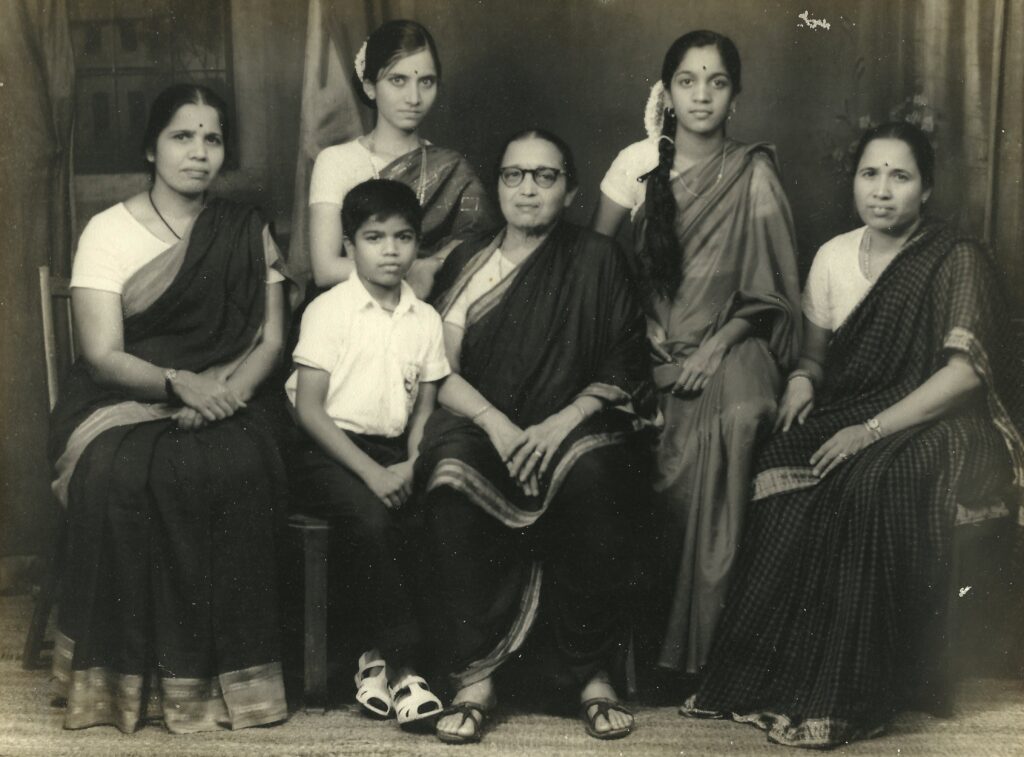
In this school, I studied a booklet called Śabda-rūpāvalī which gives declensions of nouns. My task was to memorise it. I had no idea of how the sentences arose from these nouns until I had learned other parts of the language.
My reward for doing a week of learning and practising used to be a visit to a local `sweet shop’, so named because they sold sweets, and conveniently located just across my Sanskrit school.
The next phase of my Sanskrit studies was while I was in high school. Part of it was from Sanskrit classes during the last three years of high school. But the more important learning happened under the tutelage of a Sanskrit teacher by the name of Vasanta Ananta Gadgil. I would visit his single-room apartment at five in the morning, and he would listen to my recitation of a book called `Amarakosha’–-a book of Sanskrit verses, containing synonyms and antonyms. He would appear to be resting his eyes, but if ever I made a mistake, he would open his eyes and correct me.
Much later, after I joined the University of Kentucky, I completed a voluntary project of encoding the Amarakosha with help from two e-friends, and released it for public use on the internet at the website sanskritdocuments.org. By now, there are many other resources for learning Sanskrit online, but ours was one of the first sites developed, and is still active.
Returning to Vasanta Gadgil, he used to teach in our high school, but one day he suddenly resigned. Years later, he told me that he was censured for his (and also our) fondness to go around town, presenting Sanskrit stotra recitals. Someone complained that this was an inappropriate activity for a secular school, and so my teacher resigned, rather than facing restrictions on his favourite chore. From then on, he never sought any employment. For the rest of his life, he worked as an independent reporter, promoting Sanskrit. He also produced a Sanskrit periodical named “Sharada”.
He was known for his exceptional skill of lecturing in Sanskrit to even young students in elementary schools, and getting them to understand the language, by his intonations, and use of simple words. He taught me to deliver a speech in Sanskrit. My first speech was written by him, and I memorised it. Later, I learnt the knack and delivered many such speeches even without preparation. Once, after I had returned from the US for a visit, he put me in a spot by asking me to deliver a speech to a gathering of people who had formed a Sanskrit speech club.
happy to wake up early listening to M.S. Subbulakshmi’s Venkateshwara-Suprabhatam on the radio
Were you always, i.e, right from your childhood, academically oriented, or, did it happen sometime later? Were you also a keen sportsperson, for example?
AS: Yes, my interests always centred around academics. I was a “bookworm”.
I was never seriously interested in sports, even though I practised some of them in the early part of my life. I did like to swim, and did learn to perform on a malla-khamba (a wooden pole on which one does gymnastics), but by the end of middle school, I rarely took interest in sports.
Apart from academic interests, were there other non-sporting extracurricular interests as well, say, music or poetry and such?
AS: I did not like music of any kind except for stotras, especially Sanskrit ones. I was happy to wake up early only to listen to M.S. Subbulakshmi’s Venkateshwara-Suprabhatam on the radio.
I had no individually driven choice of music at all back then, and almost never missed it in my life. My mother would then say that I was an “Aurangzeb of music”. Aurangzeb was famous for banning music, since it was not allowed in Islam. Even in today’s world, there are many Aurangzebs.
But the situation changed when I came to Purdue to study with Shreeram Abhyankar. In 1969, I had a roommate by the name of Sudhakar Kunte at Purdue, who was a connoisseur of classical Indian music. He would often listen to his collection of records. The music slowly attracted me, and I became a lover of Indian classical music, with a special attraction to vocal north Indian music, or Hindustani music.
I made several attempts to learn to sing, or play an instrument, but have not yet succeeded in creating any kind of music which even I myself would agree on. But, I have not given up yet!
I now enjoy listening to music, and I have been sponsoring Indian vocal music concerts, after moving to the University of Kentucky.
When did the first serious interest in mathematics begin to form in your, then young and impressionable, mind?
AS: While in high school, I was “good” in mathematics, but I was only interested in it as it was presented in textbooks.
In fact, after my first year in college, I joined IIT Bombay to study towards becoming a chemical engineer. I hoped then to make some discoveries in science! Within two months at IIT, I observed that after spending 2 hours in an engineering drawing class, I could not even see the details of my own technical drawings. I had serious problems with my vision since birth, which was later diagnosed as the smallness of my posterior eye cavity.
So, I decided that I needed to find a subject to study, where weak eyesight would not be a serious issue. After some thought and searching, I concluded that mathematics was that ideal subject! There is a list of famous mathematicians who went blind, going back to Leonhard Euler, including the famous topologist Lev Pontryagin.1
So, I made a decision that I would pursue mathematics as my career. I returned to the sciences’ curriculum, and after promising to do well, I was allowed to join late. At this time, I had no mentor for mathematics beyond textbooks.
From your school years, was there a major influence in the form of a mentor, or a teacher who triggered off your interest in academics, including mathematics?
AS: I was lucky to have school teachers who would challenge me with difficult problems and questions, and these challenges were not restricted to only mathematics. I had good teachers in other subjects too.
Do you recall a book, or a mathematical classic, as being your first serious introduction to mathematics, and which you intuitively felt not only transcended ideas beyond the prescribed syllabus but also held within its pages, the prospect of leading you to explore it deeper?
AS: I do not recall any specific book from my high school days. But during college, I did read many interesting books on mathematics. I do not recall any specific names, but recall the enhanced interest.
There is a bit of a story related to this. In college, textbooks were always expensive, and many students would use the study hall to borrow and read the textbooks. Thus, it was very crowded, and you may have had to wait a long time to get the book you needed. The college library would not allow anyone to browse books directly in the library. You had to select the name of a book, and then request to borrow it. But how would a student know to ask for unknown books to borrow, without browsing through several books? The standard response from the library was that students misplaced books during browsing, and so some books got “lost”, even though they might still have been placed somewhere else in the library.
My high school buddy Dhananjay Borkar and I decided to ask for an open library and started a petition for it. We argued with the professor in charge of the library, and also talked to various mathematics professors. We also offered to monitor the library’s mathematics books, at specified hours.
Finally, to keep us from causing any further trouble, the college decided to give just the two of us a special privilege to use the library freely! Since most other students were not ready for our “revolution”, we had to accept this compromise. So, from waiting in the study hall for textbooks, we started browsing through many non-textbooks as well. Naturally, we found many books which stirred our interest in mathematics, and also Sanskrit. It was very stimulating.
Sadly, most libraries in India still keep the “no browsing” rule firmly in place. Later I found out that our high school library contained many interesting old books which I had not even heard of. The library would only fulfil written borrowing requests. I think it is also useful to have one library designed for students and users from many different subjects, with all subjects stacked and carefully organised, but under one roof. At the University of Kentucky, we had an engineering student who went to Arizona, and picked up a lot of mathematics, simply because the shelves for various subjects were all stacked next to each other, all in one place.
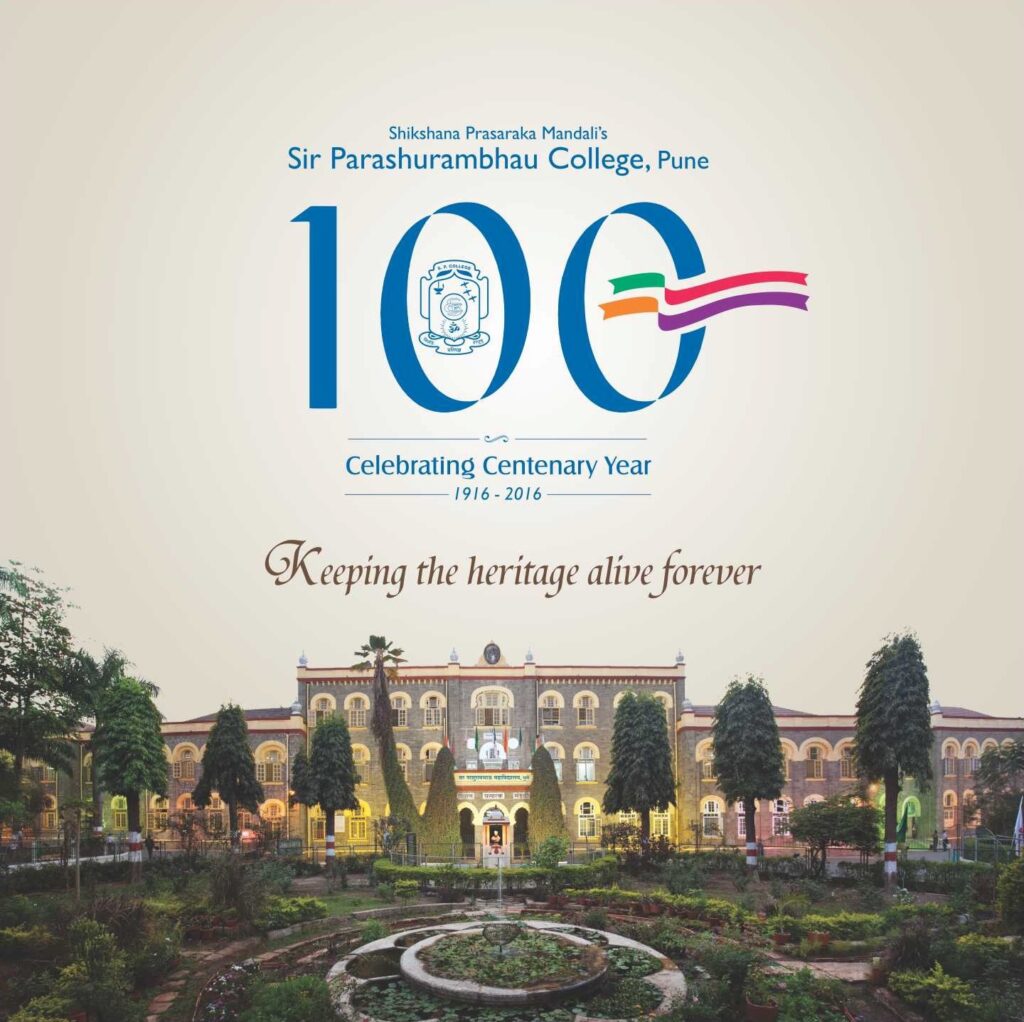
Fortunately, these days, Google has created a solution for all these problems! But it has not yet finished digitising many manuscripts hidden in libraries across India.
On the same note, was there a teacher, or a strong influence at the time of your growing up years, who helped expand your extracurricular horizons?
AS: While I had good interactions with mathematics teachers, my important interactions were with my Sanskrit teachers. These were Mr. and Mrs. Arjunwadkar. While I took only a couple of introductory courses of Sanskrit in S.P. College, my main source of knowledge was at their home. I would often visit their house, and learn various interesting parts of philosophy.
I was already curious about the details of Vedanta, and I managed to learn the Upanishads from Mr. Krishna Arjunwadkar. This was not typical classroom learning. It was more of a chat, and an evaluation of what I had learnt. He helped me with participation/presentation in Sanskrit conferences. Towards the end of my college, I even produced an Upanishad, called `Vittavasya-Upanishad’, which was more like a spoof, criticising a prevalent social obsession with money. He also inspired me to write several Sanskrit stories.
Our college used to have an annual essay competition on commentaries and thoughts on the Gita. During those four years, I was the winner for commentaries on the Gita authored by R.D. Ranade, Lokamanya Tilak, Vinoba Bhave and Mahatma Gandhi.
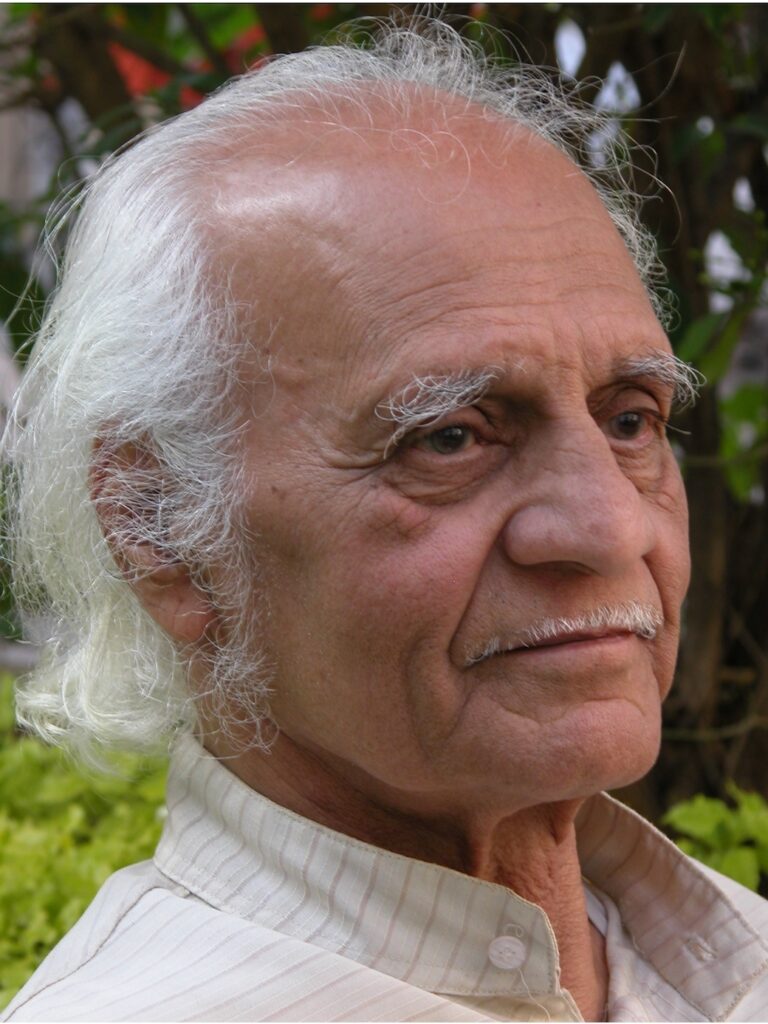
My greatest inspiration came after I met Shreeram Abhyankar in my third year of college, in 1966. It determined the direction of my future learning and career.
When did a serious interest in the Sanskrit language and Sanskrit literature, and an allied interest in the philosophical and literary texts on one hand, and mathematical treatises on the other, begin to take root in your mind?
AS: My earlier responses contain certain details, albeit briefly. Despite my love for Sanskrit, my interest in Indian manuscripts on mathematics came only about, or even after, 2001!
This happened when, as the Director of Undergraduate Studies, I assigned myself to teach a course on the history of mathematics, around or after 2001. Around that time, we were in the process of developing a minor in Indian studies at the University of Kentucky. At the same time, I was also participating in teaching Sanskrit as a linguistics course. This course was created by my friend Greg Stump in the English department. Thus, we attached the maths history course as an elective to the degree in Indian studies.
Naturally, I was interested in describing developments in India, and hence studied the Sanskrit classics. I also realised the contributions by Jains, and hence acquired as many of those sources as possible. Unfortunately, Jain mathematics is usually embedded in religious texts. It took a long time for me to figure out all the places where it could be found; a difficult task since I had not learned the Prakrit languages before. I am still not sure of having found all the mathematics in Jain texts.
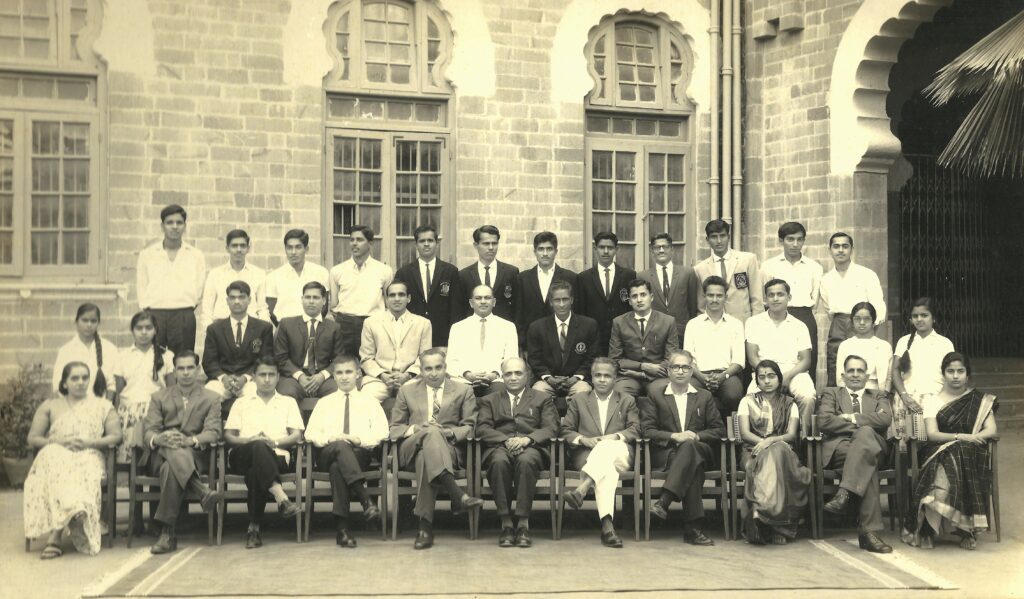
Where did you earn your undergraduate degree, and what were the subjects you studied then? Did the undergraduate experience whet your appetite for more mathematics?
AS: My B.Sc. was earned in 1967 from the University of Poona with the following subjects–Mathematics, Physics and Statistics. Yes, I did learn to appreciate mathematics more and more, especially through my interactions with Abhyankar, which happened after 1966.
When did you first hear of Professor Shreeram Abhyankar? And when did you first meet him in person?
AS: Once my college teacher, Professor Udupikar, told me that one Prof. Abhyankar was visiting Pune and that he had extended an open invitation for anyone interested in talking about ideas in mathematics.
He, in fact, took me to Abhyankar’s house, where I spoke to him for nearly about three hours. After inquiring about what I knew, Abhyankar asked me if I had any questions to ask.
I asked him for a proof of the fundamental theorem of algebra: `Every non-constant polynomial in one variable with complex coefficients has a complex root’. I had not yet learned the theory of complex variables, so the usual proof using complex variables was naturally out of the question.
Abhyankar proceeded to give a proof of why the set of values taken by such a polynomial is both open and closed. If the set of values is both open and closed, the set of non-values is also open and closed. But complex numbers are simply connected, so the only possibility for the non-value set is to be empty!
Of course, this proof had many pieces that I had not yet formally studied, but I still could make sense of it, and eventually, I was convinced of its truth. I was also hooked!
Besides a general discussion, we also discussed Sanskrit and Marathi verses, and even some philosophy. We also played a game of chess.
We have heard that Abhyankar’s lectures were masterly, absorbing, and elevating. What was his lecturing style? Was he systematic, or was he also prone to instantaneous improvisations, dictated by the need of the moment?
AS: My first session described above exemplifies Abhyankar’s approach to “teaching”. He never attempted to give a detailed formal proof in a lecture, but always tried to make his ideas clear, and the proofs believable. Of course, a lot was still left for the student to learn by himself. One had a choice to visit his house for a long night session, and ask questions. But what he wanted the students to do was to learn the details on their own first, and then ask detailed questions. He never tired of answering questions.
How did the opportunity to pursue a PhD at Purdue University materialise?
AS: I used to meet with Abhyankar every summer when he used to visit India. He talked to me about algebraic curves and commutative algebra, always providing me with newer ways of looking at related concepts.
At around the same time, I got interested in Set Theory and the Axiom of Choice. I had read a book by Herman Rubin and Jean Rubin (a mathematician couple at Purdue) titled`Equivalents of the Axiom of Choice’. Their book stated that the axiom is equivalent to the assertion that the power set of any well-ordered set, can be well-ordered (without invoking the axiom.) One of the unknown cases was to show that the set of reals can be well-ordered. I thought that I had a method to well-order the reals. I presented my argument to Abhyankar, and after a week of discussion, he found a hole in my “proof”. Soon after that, he asked me if I would like to come to Purdue and continue my studies there. I said that I had not thought about it and that I would think about it. Eventually, he convinced me to apply, with the promise of an assistantship. I consulted with my mother and then decided to take up the opportunity.
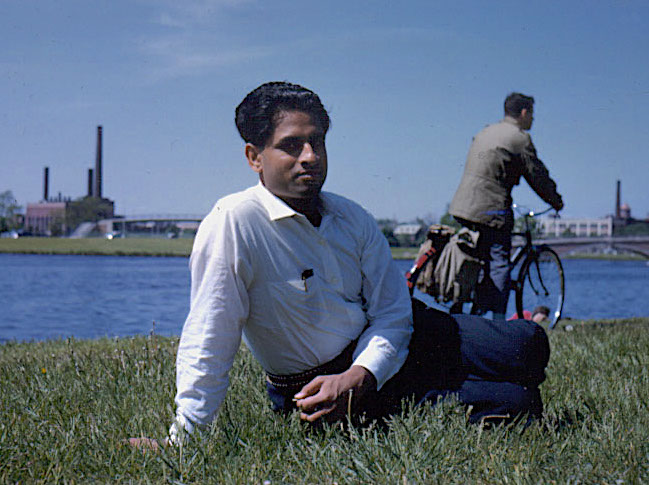
My greatest inspiration came after I met Shreeram Abhyankar in the third year of my college
There was a kink in the plan, though, which I did not become aware of until much later. The head of the department at Purdue was not comfortable with allowing a student from India. Abhyankar had had an Indian student before too, who had quit very early. So, Abhyankar had to promise the department that I will finish my degree! So, I got admitted without completing the usual formalities required, before coming to the US.
After my final PhD defence, the department head told me that he had been watching my progress and that he was happy about my success. After that, all of Abhyankar’s students were accepted at Purdue, with financial support. Earlier, I had finished my undergraduate degree in 1967, and in consultation with Abhyankar, we had planned that I will finish my M.Sc. degree at the University of Poona, and then go to Purdue in 1969.
Could you please tell us a bit more about your interactions with Abhyankar, first as a student and then as a friend and a collaborator?
AS: Abhyankar was always very helpful, and our multiple discussions on mathematics, Marathi, Sanskrit, Philosophy continued unabated. After getting to the US in July 1969, I spent time with Abhyankar, until I found a place to live, and also had a means of transport–a bicycle. Then Abhyankar went abroad for his lectures, for the fall semester.
On my very first travel to Purdue from India, I had the option of either receiving a plane ticket (which was expected to be paid back for, after landing a job) or a free ride on a cargo ship, sponsored by the Scindia Steam Navigation Company. I opted for the latter. They put me up in a private room with a personal assistant, in the same building where the officers stayed. At that time, the ship took a month to travel, since the Suez Canal had been closed due to an ongoing war. Two years earlier Madhav Deshpande, a Sanskritist friend of mine, had used the same scholarship, also travelling by ship. I knew that Abhyankar too had travelled on a ship sometime, and that too was a source of inspiration. The name of the steamer was Dharma Teja, and we sailed past the Cape of Good Hope. Somewhere along the voyage, I was summoned eagerly by some fellow travellers, and we all gathered at a high viewing point of the ship. There, someone pointed out to the Moon visible in the sky and remarked, `It is no longer uninhabited. There is now a man on the Moon’. It turned out to be a truly unique experience. It was the second half of July 1969 then.
I spent my first semester studying for my two prelims–algebra, and topology (including differential geometry). After I finished both at the end of the semester, Abhyankar returned and happily told me that I should now concentrate on `doing’ mathematics. He was very helpful and very generous with his time.
Those days, Abhyankar used to work all night and went to sleep in the morning. Naturally, he got up late in the afternoon. As a result, I had to learn to stay up for many hours at night. I was amazed that most of my eye problems vanished after this. Perhaps, mathematics was the cure!
Abhyankar would discuss questions that he was working on, and I too would try to learn them. So his questions became my problems too. He never formally assigned me a problem and I learned by working with him, rather than working for his assignments. At the time, I was the only student he had, and this was an unusual process for me. However, I did have plenty of experience discussing mathematics with my other teachers outside of class. Later, when he acquired more students, they had to make appointments with him to meet at specific times; but he rarely refused to meet them. His weekly seminar was two or more hours long, and he had a general invitation for students to come to his house for further discussions at night. His house was only two blocks from the department.
Somewhere along the voyage, someone pointed out to the Moon visible in the sky and remarked, ‘It is no longer uninhabited’
He would suggest books to me to read, but never formally asked me for details of what I read. This was his “teaching method”, and there was never a formal exam in his classes.
The exam was to solve the problem under consideration, and the grades were never measured in terms of numbers, or letters. Of course, he expressed his happiness in response to any success, and so it continued.
I was teaching elementary classes for my assistantship’s salary, and taking other classes for my own learning. He rarely showed interest in how I was doing, but often his questions were directed towards the content of my courses.
I had already learnt how to read books in my own way. First read through a book quickly to absorb the main themes in it, and then later dig into specific topics of interest. I would avoid reading the proofs from the book, and read them only if I could not prove the statements myself. Sometime later, he told me that he used the same technique!
Abhyankar used to travel a lot, giving lectures, and he asked me to accompany him whenever possible. This was a way of introducing me to the world of mathematicians, and learning about other points of view.
In 1970, I went to a three-week seminar in Montreal, where the speakers were Abhyankar, Masayoshi Nagata, Michael Artin, and Alexander Grothendieck. I got the task of taking the seminar’s lecture notes, together with Peter Russell (who later became a lifelong friend and collaborator). This seminar gave me a deeper appreciation of algebraic space curves, and suggested many specific topics to study.
Abhyankar wrote the way Zariski talked, and talked the way Zariski wrote
I could simply go on describing my experiences of having Abhyankar first as a teacher, and later as a collaborator.
Around the time you met Abhyankar and started interacting with him formally, Bourbaki’s influence in mathematics had become almost all-pervasive. The powerful influence wielded by the likes of André Weil, Jean-Pierre Serre and Alexander Grothendieck had begun to create deep inroads into many of the most important and pressing questions of algebra, geometry and number theory. Yet, Abhyankar resisted the Bourbaki influence and did it in his own charismatic style. In fact, he has articulated on different occasions the importance of a strong grounding in classical algebra (or what he liked to call high school algebra), and analytic geometry, for arriving at or for understanding the essence of even the deepest mathematical ideas. Did he try to make even his students see this point of view?
AS: It is true that Abhyankar was not in favour of the Bourbaki school, but the reasons were not owing to a personal whim. Indeed, he had studied their methods, and occasionally even used some of their results. His main objection was towards people who would use theorems without getting a good idea of their intricate details, and thus were incapable of explaining their own results explicitly. In his own words, he appreciated the depth of mathematical works, rather than their expanse. In his view, many (if not most) theorems proved by followers of the Bourbaki school were only partially proved, until completely expressed in all its detail; or, at least, the person proving such theorems had to be doubtless capable of doing so.
I have seen him demand a complete explanation, even from experts. However, his criticisms were never directed towards Jean-Pierre Serre, because Serre always provided explanations acceptable to Abhyankar’s demands.
He was never opposed to his students learning from the Bourbaki school, except that he insisted that they learn all the inner details, and also be able to explain them.
I would like to add that he, however, did not get into the logical aspects of mathematics, even though he admired the work of the logicians. Perhaps, that might also be why he did not criticise me for my efforts with the axiom of choice.
Abhyankar’s PhD guru at Harvard, Oscar Zariski, earned his PhD working under Guido Castelnuovo at Rome, and was a product of the Italian school of algebraic geometry, famous for its intuitive approach. Yet Zariski, more than anyone, played a huge role in making the foundations of algebraic geometry rigorous. As a student working directly with Abhyankar, did you sense a constant tussle in his mind between rigour and intuition, both trying to influence his thoughts, and thereby, those of his students too?
AS: My observation is that Zariski lectured very formally, giving statements followed by their proofs. Usually, he did not worry about extra explanations. His papers were very reader-friendly, and he would provide enough motivation to support his arguments.
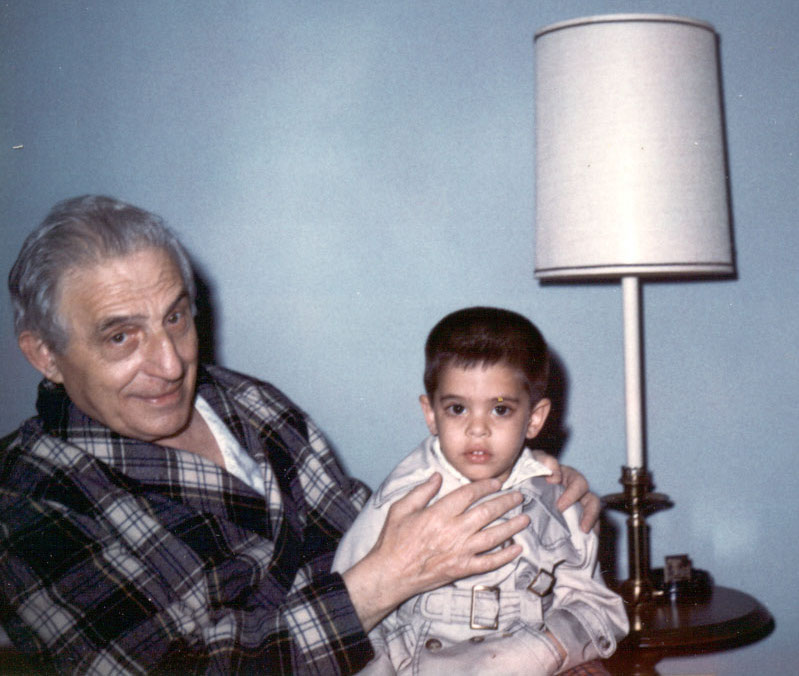
So, I think they both had a judicious mixture of intuition and rigour. Perhaps, Zariski preferred fairly formal talks, since he was trying to impose a new rigour on an originally Italian style of exposition, but he returned to the Italian expository style in the papers. In other words, Abhyankar wrote the way Zariski talked, and talked the way Zariski wrote.
What problem did you take up for your PhD thesis, and what was your motivation to think that it was an interesting idea to pursue, or explore?
AS: As I mentioned before, my topics of interest during my stay at Purdue were those that Abhyankar was trying to solve himself. One of the outstanding problems was to analyse algebraic curves2 in 3-space (that is, a polynomial ring A_3=k[X,Y,Z] in three variables) which are complete intersections. This means curves whose ideal in 3-space is generated by two polynomials. It was expected that rational nonsingular curves would have this property if the Serre Conjecture were true. The Serre Conjecture states that all projective modules over polynomial rings are free. The Serre Conjecture was considered an important unsolved problem. It was proved for polynomial rings in one or two variables, but the case of three variables, that is for projective modules over the polynomial ring A_3, was open. An active effort to prove the conjecture was undertaken by many mathematicians.
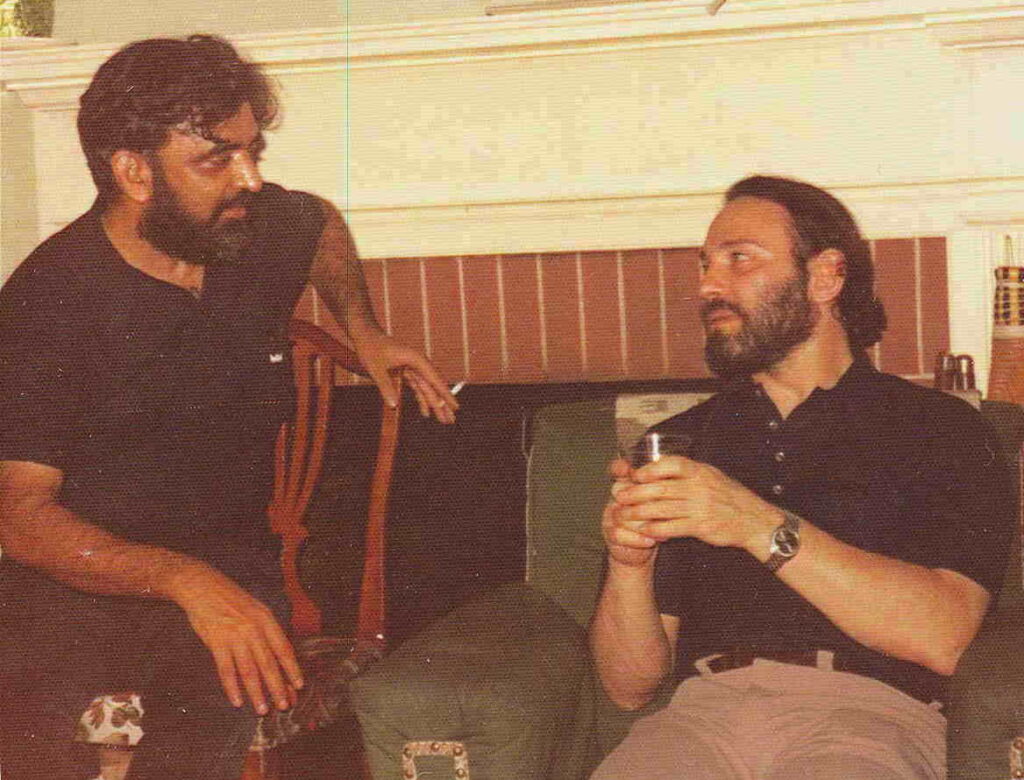
Abhyankar was trying to directly attack the complete intersection problem. In his characteristic fashion, he proceeded to determine ideals for all nonsingular curves in 3-space. In particular, he searched for generators with the smallest Z-degrees. I joined his program, and its final outcome was three generators: one of Z-degree 3, and two of Z-degree 1. So the question was reduced to finding the conditions for this number to become 2. Abhyankar had found some sufficient conditions, but it was not clear if they were satisfied in general.
On another track, if one considered only polynomial curves (a curve whose coordinate ring is a polynomial ring in one variable is known as a polynomial curve), then one can expect to prove them to be complete intersections.
I pursued a simpler problem, namely to check this for curves of small degrees. This involved some geometric arguments, and all curves of degree at most 5 were shown to be complete intersections.
Then, the Serre Conjecture for three variables was established by Pavaman Murthy and Jacob Towber. It was interesting that they used the three generator construction of Abhyankar to create a suitable representation for a projective module of rank 2, and then proved it to be free! Of course, Serre’s conjectures in this area were soon settled in their finality in later years by two independent methods, one by Dan Quillen, and another by Andrei Suslin. Our own results were published in a book in 1974, in the Lecture Notes in Mathematics Series by Springer, and was titled “Geometric Theory of Algebraic Space Curves”.
For technical reasons, my published thesis has two parts unrelated to this work. One was on `Convergence sets of divergent power series’, and the other was on `strong disjointedness’. The technical reason was money. The actual thesis would have been too expensive for me to have got it all typed by myself! For getting a book typed, though, the department had a budget that I could dip into. Of course, at that time in 1973, we were still five years away from the first release of TeX, as well as reasonably-priced personal computers.
Abhyankar is considered one of the pioneers in the area of affine algebraic geometry, or affine geometry. What exactly does the word “affine” mean? For the benefit of our broad readership, can you elucidate in the simplest possible pedagogical terms, what this area of algebraic geometry seeks to address and understand?
AS: My answer here first describes the notion of affine geometry and then describes the development of the Abhyankar-Sathaye conjecture as an example.
A good starting point is to think of affine spaces: That is, line, plane, 3-space and so on. Algebraic models for affine spaces, in general, are polynomial rings in 1,2,3, or more variables over a field k. The underlying field depends on what kind of geometry we are studying. We may use the field of reals, complex numbers, rational numbers, and so on.
For our discussion here, we shall assume that the field k is that of complex numbers. For convenience, we call the corresponding polynomial rings A_1,A_2,A_3,…. If I is an ideal in some A_n, then it is said to define an affine algebraic variety and the coordinate ring of this affine algebraic variety is A_n/I. This ring represents all polynomial functions on the variety defined by I, since functions which are equal modulo I are identified with each other in A_n/I.
In general, affine algebraic geometry analyses such varieties (represented by I), or their coordinate rings. While the subject covers many different topics, Abhyankar’s work mostly addressed itself to those ideals I in A_n for which the coordinate ring A_n/I is isomorphic to a polynomial ring, say A_m. If this happens, then it is not difficult to see that m \leq n.
One simplest example is to take I to be an ideal in A_n = k[X_1, X_2,\cdots, X_n] generated by X_1,X_2,…, X_{n-m}. This is described by saying that I is generated by (n-m) variables. The Main question is: If A_n/I is isomorphic to A_m, for some m\leq n, then is I generated by n-m variables? That is, can we find Y_1,Y_2,…, Y_n which generate A_n such that I is generated by Y_1,Y_2,…, Y_{n-m}.
For n = 1, the answer to the main question is easily seen to be yes! For n = 2 the Abhyankar-Moh theorem proves that the answer is also “Yes” if k has characteristic 0.
However, if k has a positive characteristic, then the answer is no. A counterexample in the case n = 2, m = 1 is given by I = (X_1 - (X_3 - X_2)^2), if the characteristic is 2. This belongs to the family of examples created by B. Segre.
The problem of determining all ideals (g) such that A_2/(g) is isomorphic to A_1 is still not resolved in positive characteristic. The case of n=3 with m=2 is the first unsolved question in characteristic 0. In general, if n = m + 1, then the expected ideal I is clearly a principal ideal I = (f), and the question can be paraphrased as follows:
Is every hypersurface in affine n-space with coordinate ring isomorphic to A_{n-1}, a variable in A_n? In other words, can we find n-1 polynomials Y_2,Y_3,…,Y_n so that A_n = k[f, Y_2,…,Y_n]?
The Abhyankar-Sathaye conjecture is that the answer to this question is “yes” in characteristic 0. In general, the conjecture says that for any n>3 and m = n-1 the answer is still yes. What about the case n=3 and m=1?
Consider an epimorphism \phi from A_3 to A_1 (i.e., a line embedded in 3-space). The question is whether there are f,g in A_3 such that the ideal (f, g) is equal to {\rm Ker}(\phi). Further, is (f,g) a variable-pair in A_3? In other words, are there Y_1,Y_2,Y_3 in A_3 such that A_3=k[Y_1,Y_2,Y_3] and k[f,g,Y_3]=A_3? If k is the field of reals, then there are several examples of curves in A_3 which are isomorphic to A_1 but have knots–-i.e., the fundamental group of the complement of the curve is different from that of the complement of a line. Then the ideal I cannot be generated by two variables.
On the other hand, if we go to the field of complex numbers, then the obstruction from a fundamental group of the complement does not exist, but the answer is still unknown. It is, however, easy to prove that when m = 1 and n > 3, then the answer is yes!
Why is it that the Abhyankar-Moh epimorphism theorem could resolve the case n=2 and m=1, and yet the very next case for n = 3 with m = 2 is only partially proved? One way to see the reason is to note that one had a complete understanding of the automorphisms of A_2, and so we already knew what the variable f should look like. In the case of A_n, with n>2, the description of the automorphisms is still missing.
For A_3, we know the triangular automorphisms which are given by \[\begin{array}{c}
(X_1,X_2,X_3)\rightarrow
(Y_1 = c_1X_1,\ Y_2 = c_2X_2 + u_1(X_1),\ Y_3 = c_3X_3 + u_2(X_1, X_2)),\end{array}\] where c_1, c_2, c_3 are non-zero elements of k and u_1(X_1), u_2(X_1,X_2) are polynomials in the indicated variables. One can similarly define such automorphisms for A_n as well.
A composition of triangular automorphisms is called a `tame’ automorphism. A new type of automorphism introduced by Nagata was an automorphism f for which f(X_1)=X_1, and the images of X_2, X_3 give an automorphism of a polynomial ring in two variables X_2, X_3 over a base ring k[X_1]. For many years, it was unknown if the Nagata automorphism was tame or not. In 2003, it was proved to be non-tame, or `wild’, by I.P. Shestakov. So the best guess now is if every automorphism of A_3 is composed by Nagata type automorphisms.
We understand that one of the early landmarks in affine geometry is the “Abhyankar-Moh Epimorphism Theorem”, for which we hear Abhyankar had a special fondness. Were you a witness to these exciting developments? Can you share some reminiscences on it (for instance, on the impact of the result)? Will it be possible to convey to a non-expert what the statement is about?
AS: Yes, I was a witness to the proof of the Abhyankar-Moh theorem, even as it was being developed, and finally published. Let me set up some essential terminology first.
Assume that k is an algebraically closed field of characteristic 0, such as the field of complex numbers. Start with the plane, which, in algebraic terms as mentioned before, means a polynomial ring in two variables, say A = k[X,Y].
Now consider a plane algebraic curve C: in algebraic terms, such a curve is represented by a (non-constant) polynomial f(X,Y), and all polynomial functions on the curve are represented by the quotient ring B = A/(f), called the coordinate ring of the curve C, embedded in the plane A.
The problem is to prove that if the coordinate ring B is isomorphic to a polynomial ring in one variable, then by a sequence of elementary operations, f(X,Y) can be changed to uY where u is a non-zero element of k.
Abhyankar had just returned from his trip to India and had some ideas about a possible proof using the genus formula, and other techniques from the algebraic geometry of curves. Tzuong-Tsieng Moh was at Purdue. When they got together, I was sitting in Abhyankar’s office. Moh explained his idea of an approximate d-th root of a monic polynomial in Y over the ring k[X].
This means, given a monic polynomial f of degree n in Y, and a divisor d of n, we can uniquely determine a monic polynomial g of degree n/d so that f = g^d + u_1g^{d-1} + \cdots where u_i are polynomials with Y-degree less than d; moreover, where u_1 is the zero polynomial.
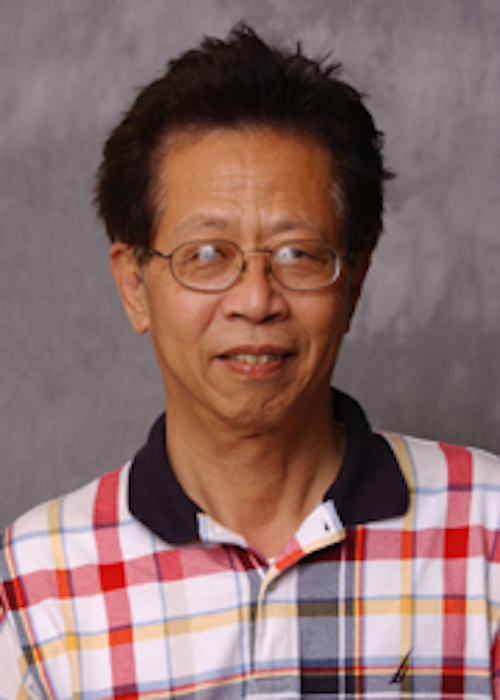
Abhyankar was doubtful about this claim at first, but within a day he realised its power. It allowed a full determination of the degree semigroup of a curve with one place at infinity. The curve f(X,Y) = 0 has a coordinate ring k[X,Y]/(f(X,Y)) = k[x, y], where x,y are images of X,Y under the canonical homomorphism. This semigroup can be described as negatives of all values of functions in the coordinate ring of the curve f(X,Y) = 0, where the valuation is the unique valuation of the curve f(X,Y) = 0. The epimorphism theorem follows very easily, since a purely arithmetic calculation proves that if 1 is in the semigroup, then the degrees (n,m) of (x,y) form a principal pair, meaning m divides n, or n divides m. We note that (n,m) can be also shown to be equal to ({\rm deg}_Yf(X,Y),{\rm deg}_Xf(X,Y)), and these degrees are just visible in f(X,Y). So, the pair (n,m) is the principal pair in either interpretation. We can then use an elementary automorphism of x, y to reduce at least one of the two degrees.
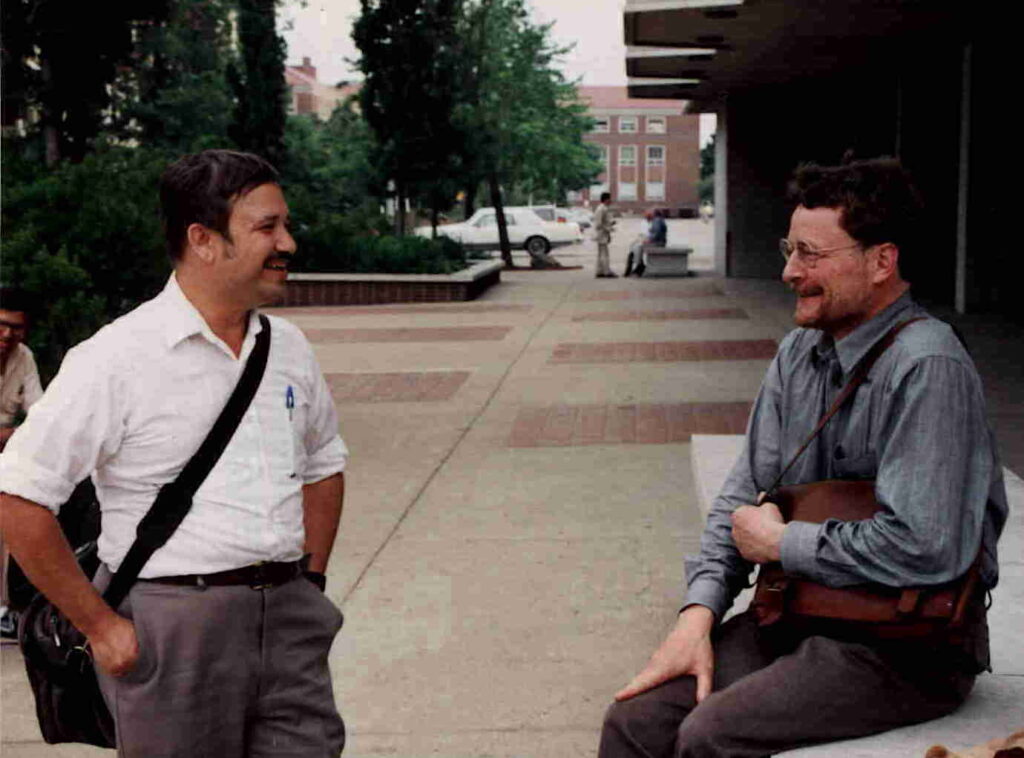
One of the central problems in affine geometry, we believe, is the “Abhyankar-Sathaye Conjecture”, which seeks to generalise the Abhyankar-Moh epimorphism theorem to higher dimensions. Can you tell us about your work on the first special case in which the conjecture was confirmed?
AS: The first case I proved was the linear case. If f = \alpha Z + \beta with \alpha, \beta in k[X,Y] and k[X,Y]/(f) is isomorphic to A_1, then the coefficient \alpha can be shown to be equal to X after a change of variables. This was further generalised, in joint work with Peter Russell, to the assumption that the leading coefficient of Z is a polynomial in X. The Nagata automorphism is a special case of this. The only other case is David Wright’s proof when f = Z^n + b, and in this case, b turns out to be X.
Thus for cases when f is a polynomial with the leading coefficient of Z being a polynomial in X, we get automorphisms of Nagata type, namely automorphisms of k(X)[Y,Z] where we take k(X) as the base field, and further require that the resulting polynomial is actually in k[X, Y, Z]. This idea is related to the notion of affine fibrations.
We would now like to hear your insights into the contributions of Abhyankar to the world of mathematics, and his impact on Indian mathematics.
AS: I will concentrate on the Jacobian Problem. The problem is very easy to state:
Given two polynomials F, G in X, Y such that the Jacobian J(F, G)_{(X,Y )} = F_X G_Y - F_YG_X = 1, then is it true that F, G are variables in k[X,Y]?
The expected final conclusion can be made simpler by asking if F and G have Y-degrees n, m respectively, then is it true that n divides m or m divides n?
We need to insert one important necessary condition here, namely that k has 0 characteristic; so, the field of complex numbers is a good candidate, which is also comfortable for many mathematicians. Even further, k needs to be assumed algebraically closed since counterexamples to the real case were given by Sergey Pinchuk in 1994.
In positive characteristic, several examples produced by B. Segre are well known. For example, in characteristic 2, let F = X and G = (Y^3 + X^2)^2 + Y. Here, the jacobian is easily seen to be 1. To see that such polynomials G are not variables, one can use another known result that one of the two degrees {\rm deg}_Y(G) and {\rm deg}_X(G) must divide the other. Identification of possible forms of F, G with jacobian 1 was investigated by Richard Ganong and Peter Russell.
Moh had moved to Minnesota in the mid-’70s and he had long phone conversations with Abhyankar about his proposed proof. Eventually, he started writing his proof. It broke down on page 60. This means Moh discovered obstacles to his planned line of action.
Moh’s 1983 paper3 gives a summary of his discoveries and shows that the theorem is true for polynomials of degree less than 100. At the end of his paper, Moh writes down four cases that need ad hoc work not covered by his theorems. He does give a proof of these cases, but I have found these four examples to be an excellent touchstone for any “new proof under review”. So far, I have found holes in many proofs this way.
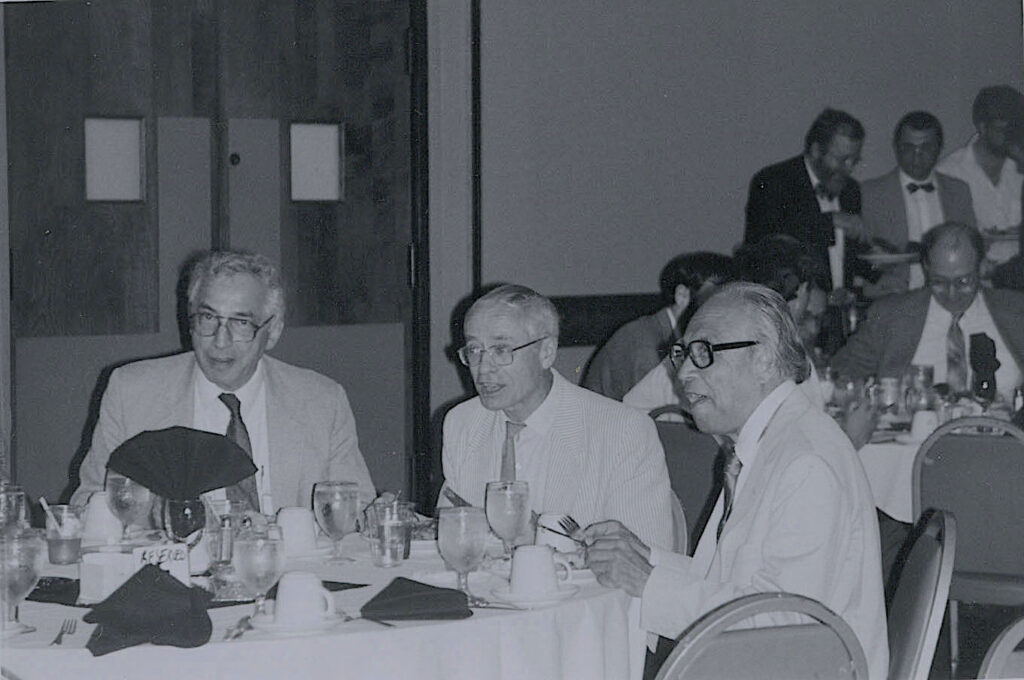 |
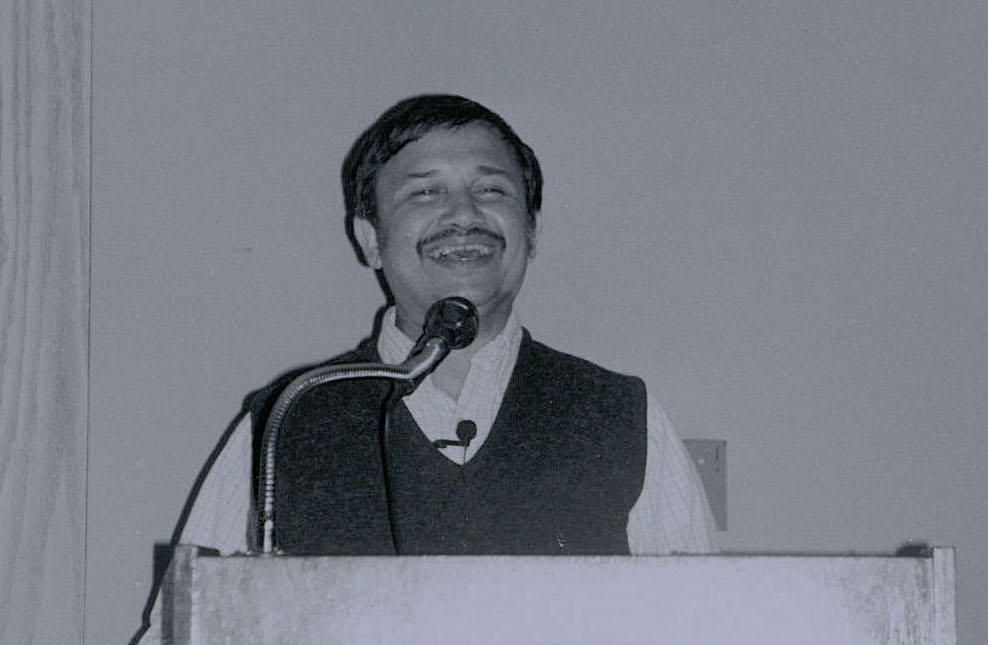 |
Moh’s 1995 paper4 gives a good basic summary of what is known at that time.
Another proof proposed by a new student of Abhyankar, named Chan-Jer Jan, made Abhyankar elated for a month, until he found the error! Jan was my officemate, but we rarely met since his working hours were very different from mine. He went on to do the field generator problem, namely, when a given F in k[X,Y] has a fieldwise mate G such that k(F, G) = K(X,Y).
Originally called Keller’s problem, the Jacobian problem was posed by Ott-Heinrich Keller in 19395. When Abhyankar was asked to evaluate Wolfgang Engel’s “proof” of the Jacobian Theorem,6 by his guru Zariski, he did create examples to show that Engel’s claims about the behaviour of a linear pencil at infinity could not be valid.
Moh later believed that he had found a proof of the Jacobian Theorem, which used the techniques of the Abhyankar-Moh epimorphism, and which would have been the most proper and elegant sequel to the theory of approximate roots of polynomials. The theory was suited for curves with one place at infinity (which have been studied in detail over the years.)
Abhyankar (and also Moh, but I am not trying to set up priorities here!) proved some useful and nice theorems. Let me simply list them here, as a sort of update, from my perspective of the status:
(1) If F is submonic in Y which means that the highest Y-degree coefficient of Y is a non zero element of k, and if it remains submonic in Y after any change of variables (X,Y) \rightarrow (X', Y'), then the Jacobian Theorem is true.
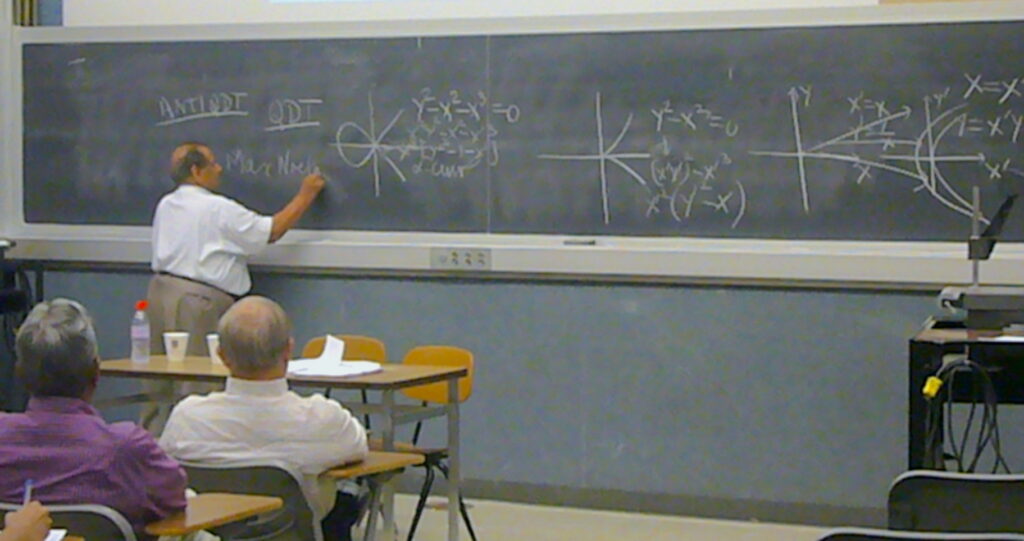
(3) When we view the pair (F,G) as giving a plane curve with parameter Y, and treat X as a constant, then the Epimorphism Theory machinery can be used, and we know the number of characteristic pairs.
The Jacobian theorem is true if the number of characteristic pairs is 1 (i.e. n,m are coprime and neither divides the other) or if the number is 2.
Abhyankar believed that he had proved the case of the number of characteristic pairs being 2 + \varepsilon, where \varepsilon is a small positive integer. His series of papers were designed to set up the correct machinery to prove all of these cases, with the goal of extending the arguments to more than two characteristic pairs.
I am partly responsible for this big effort of Abhyankar. I was given the task of preparing a paper7 based on notes by William Heinzer and Marius van der Put, based on Abhyankar’s talks, but the notes did not cover all the cases. Moreover, Abhyankar found some mistakes in my arguments. He ended up writing three long papers to resolve this issue and set up proper terminology and methods for further progress.
Abhyankar wanted to absorb more Sanskrit
Still, the aim was not quite complete, and then the dicritical divisors caught his attention. He went on a “sabbatical” from the Jacobian problem. He thought that they would provide the missing tool for the Jacobian problem. He, however, ended up with several theorems about the dicritical divisors not yet known or guessed. He created some clever induction arguments to complete the proofs.
He was probably ready to switch back, but alas, his last paper (which I had the honour to review) was written only a week before his sudden demise and the Jacobian Conjecture8 is left for those who learned from him!
Both Abhyankar and you shared many things in common–-your mother tongue Marathi, for instance. Not to forget mentioning an abiding respect and affection for an “Indic” approach in general. Seen from this context, what events led Abhyankar to establish the `Bhaskaracharya Pratishthana’ in Pune in the mid-1970s? What was his vision behind the establishment of the Pratishthana?

As far as the Bhaskaracharya Pratishthana is concerned, the first idea was to relieve Abhyankar from the task of arranging accommodations for his foreign visitors. It was to serve as a conference centre with residence attached. Another aspect was that Abhyankar was concerned that bright students from our town Pune did not come into contact with mathematics research, and so ended up losing interest in serious mathematics, owing to a lack of mentors. Thus he wanted continued activity in a place that had faculty, students supported with fellowships while attending regular classes, and with an extra emphasis on serious mathematics.
Of course, the big problem was money. It took several years, together with big efforts by Abhyankar himself, and from various other friends, well-wishers, and donors, before it materialised. We had to wait.
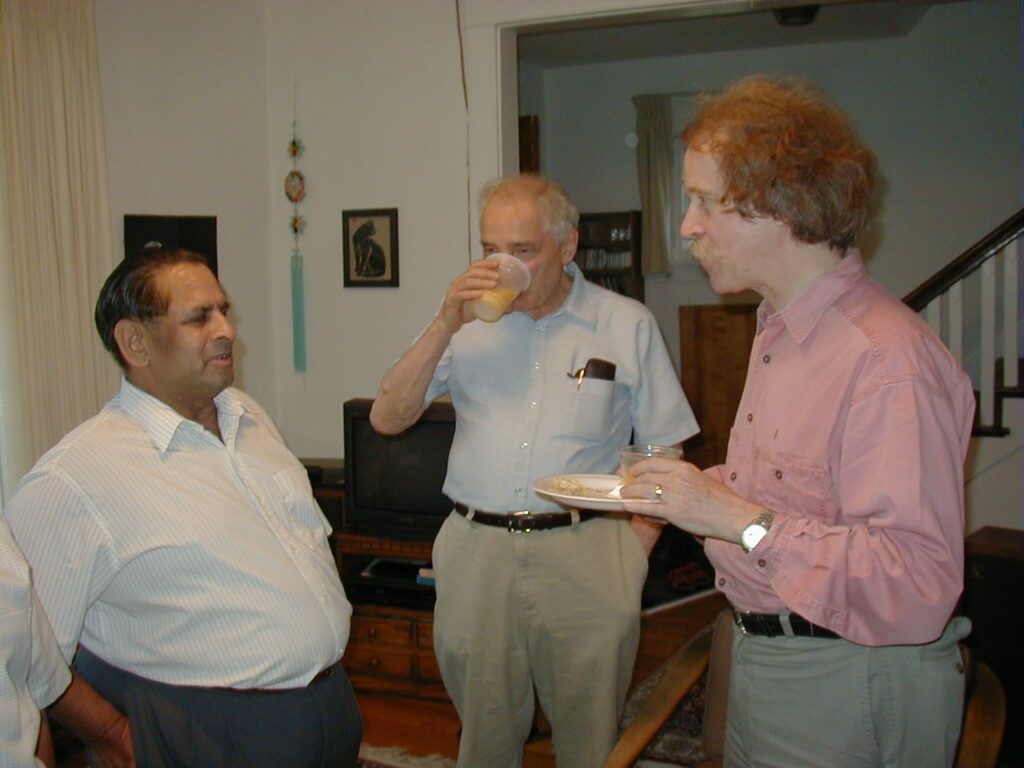
My plan was to join the institution as soon as I could earn my salary and have a decent place to work. But it was impossible for several years, and I am not sure or knowledgeable about the sources of its income. There is now a big building with classrooms, library and residences; and someday, it will start functioning as originally envisioned. But still, it does not, and cannot generate its own income, and has no reliable sources of support. There are a few faculty members with some government grants, or supported by independent income. So, perhaps, the original dream is slowly becoming a reality, but alas, Abhyankar is not around anymore to watch it grow to become what he had aspired for.
Brahmagupta and Bhāskara II had considered numbers with zero in their denominator. You have pointed out that viewed in the light of Algebra, their definitions and rules of operations can be shown to be valid in a suitable mathematical framework, and that they have analogues in modern mathematics. Can you give a brief indication of your insights on the concept? In this connection, you had once referred to Algebra as the first bold adventure into the unknown. Can you expound on your statement?
AS: Yes, both of them were well known for simply declaring that 1 divided by 0, is valid and allowed. This was not because they were ignorant of the inconsistency in such a declaration, but that they had found a different way of handling the problem.
They put all such entities \frac{x}{0} into a single new “class” called khahara, and even defined how to add or multiply such classes. Likewise, they also declared another class called khaguṇa as another number to be introduced into mathematics.
This is clear from their bold declarations of how these new entities behave under algebraic operations. The idea was that some of the operations may bring the results into reals, as for example \frac{4}{0} \cdot \frac{0}{1} = 4. More generally, \frac{x}{0} \cdot \frac{0}{y} = \frac{x}{y} clarifies that the final resulting value phala should be declared only after all calculations are completed!
I have explained this in my paper on khahara where I create three sets R, khahara = R_{\infty} and khaguṇa = R_{\epsilon} where I have introduced the usual symbol \epsilon which may become real 0 if it stays \epsilon after all the operations. Both the entities \frac{1}{0} and \epsilon are treated as idempotent!9
By the way, the exercise in Līlāvatī is different from the ones in Bījagaṇita. The exercise in Līlāvatī appears to prepare for the notion of limits. Both Bhāskarācārya himself, and his commentators have made explicit statements about this. It also seems to be to make precise his notion of `instantaneous velocity’, which is essential in predicting the timings of eclipses of Sun and Moon, and which were important for religious activities.
Brahmagupta’s exercises were clearly meant for astronomical calculations, but they did not seem to involve the khahara. I have not located any related problems in various commentaries.
Now you may ask where, and by whom, was this first stated and discussed. The concepts and indication of the calculations appeared in the two books of Bhāskarācārya entitled Līlāvatī and Bījagaṇita.
But I have not seen a mathematical explanation anywhere. I was inspired to think of justifying the two exercises in Bījagaṇita which were traditionally declared as improper (or wrong) by most commentators.
Given the brilliant work by Bhāskarācārya, I proposed to find a valid explanation if possible, or else join the criticisers of Bhāskarācārya. I was happy to find a valid explanation!
We now discuss some other aspects that have held your attention all these years–-namely Sanskrit, and a careful study of the history of mathematics in India. The name of our magazine Bhāvanā is inspired by an important contribution of Brahmagupta. Can you share your insights on some of the major contributions of Brahmagupta to mathematics?
AS: I should acknowledge that in the beginning, I was not a fan of Brahmagupta, due to his severe criticism of Āryabhaṭa and extreme rejection of the idea of the daily rotation of the earth. I believe his criticism forced the Āryabhaṭa system of calculations to find refuge in south India.
I wanted to find an explanation, or else join the criticisers of Bhāskarācārya, and I was happy to find a valid explanation!
I should point out that in his later treatise khaṇḍakhādyaka, he gives recognition to Āryabhaṭa and his work. He says “that even though Āryabhaṭa’s formulas give good answers, they take too long to calculate, and hence, I am providing better methods for faster calculations.” However, after learning from Brahmagupta’s chapters 12 and 18, I found great joy in his skills as a mathematician! Further, after learning about the vargaprakṛti (now wrongly known as `Pell’s Equation’, due to a historical mistake), the problem first raised by Brahmagupta, and finally solved by Bhāskarācārya only in the 12th century, I really started appreciating his mathematics.
His bhāvanā was already the main step in the solution to the vargaprakṛti problem, except that one still did not know how to organise the sequence of steps so as to reach the final goal–-namely, a solution of the equation Nx^2 + 1 = y^2 where x, y are integers, and N is a non-square integer.
This personal experience also illustrates how one should never determine the worth of anything by just reading secondary sources, including later translations, or commentaries! I have now learned my lesson.
In general, and over all these years, how have your twin interests, namely Sanskrit and mathematics, mutually reinforced and enriched your understanding of the other? If so, can you please give us an illustrative example or two?
AS: I regret that the two interests did not come together until the twenty-first century. As I reported above, I did not start looking into all the mathematics hidden in Sanskrit texts, until I got interested in maths history; only then did I start getting to know the relevant Sanskrit and Jain texts.
I have also heard from Abhyankar that he had learned parts of Līilāvatī and Bījagaṇita as a child, but once he got into “higher mathematics”, his respect for Indian mathematics stayed in the background.
When I started looking into the history of Indian mathematics and started reading through the actual texts, I learned more and more about the ideas and techniques in it. The study of kuṭṭaka helped me to give a simpler algorithm for what is otherwise known as the Chinese remainder theorem. I have taught the algorithm even in my other mathematics courses, since.
Elaborating on this further, what, in your opinion, is the best example of how a careful study of Sanskrit allows one to better appreciate what is actually a deep mathematical idea? Are there hidden connections and synergies between Sanskrit and mathematical ideas?
AS: My response to a question above is a concrete illustration of this.
I have also learned a lot after studying the “extension” of the vargaprakṛti. This “extension” asks the question: What are all the values of c such that Ny^2 + c = x^2 when N is a given non-square integer, and x, y are integers? Further, we can even ask for a primitive solution, which means x and y now do not share a common factor.
My original love of Sanskrit arose from how it sounds. Vedic chanting and recitation of Sanskrit verses provide to me the same inner aesthetic satisfaction
First, I asked my friends in number theory and they suggested ideas of reducing the search to a finite (albeit very large) number of cases.
The other possible idea is to consider the number c as a value represented by the quadratic form x^2-Ny^2. This involves determining the class of this quadratic form, and then solving for congruences imposed by all prime factors of N in order to determine the answer, by following up on every single possible solution.
Jason Wang, who is still a high school student in his senior year, and I have shown how the answer can be deduced from Bhāskarācārya’s solution process, and how it is also a definitive process.
Our work needs A.A. Krishnaswami Ayyangar’s10 explanation of the Bhāskarācārya process.
This illustrates how works in Sanskrit, when properly analysed in terms of current mathematics, can possibly even generate new results in mathematics.
What are your views on the Sanskrit language as a whole? Also, what aspects or salient features of some texts in Sanskrit literature fascinate you most?
AS: My original love of Sanskrit arose from how it sounds. Both Vedic chanting and recitation of Sanskrit verses provide to me the same inner aesthetic satisfaction.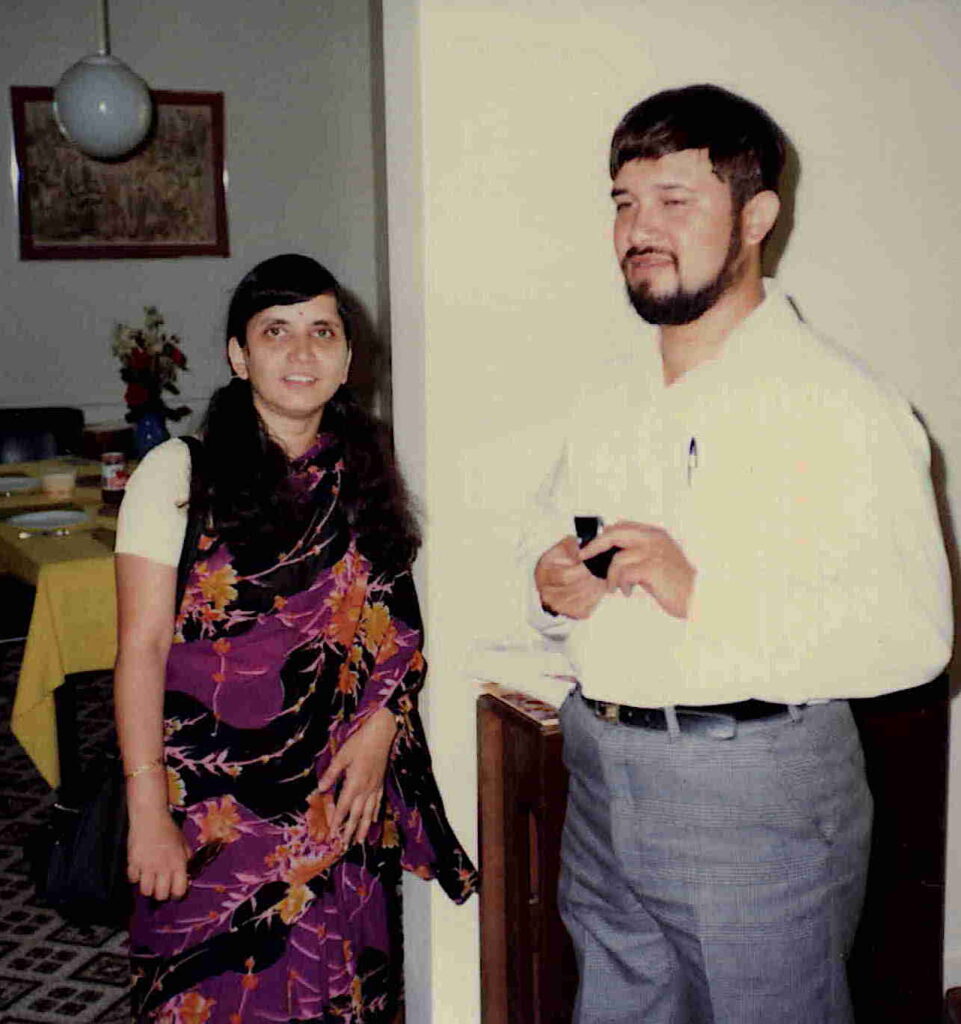
The whole kaṭapayādi system of writing numbers is very amusing, and at the same time useful for memorisation. It is this feature that lets poets compose entire stotras, simultaneously praising two different gods! I think its intrinsic complexity induces continuous intellectual stimulation.
I should include another aspect of my love for Sanskrit, namely my wife Shashi. We were together on a trip to Delhi for a Sanskrit conference. Shashi and I were already mutually attracted, due to our common interest in Sanskrit. She had formally studied nyāya11 and we would often discuss Sanskrit. During the conference and an excursion organised at the end of the conference, our love of Sanskrit turned into romantic love as well.
Until I came to Purdue in 1969, we did not pursue it further; but in 1970 she came to Purdue, to marry me. At that time, I only had enough money to buy her a plane ticket. So, she brought with her an audiotape containing the ceremonial wedding rituals, recorded earlier in India in a mock wedding. After she came to Purdue, we got married on a porch at Abhyankar’s house! The priest who got us married was that very same tape-recorder. The role of my parents was played by Abhyankar and his wife Yvonne (Usha, for the family in India). The role of Shashi’s parents was played by a Marathi student at Purdue, and his wife (the Joshis).
We would talk to each other in Sanskrit, and later after our son Adheesh was born in August 1973 (the same month when I also finished my degree), we would make it a point to speak to him in Marathi, as well as in Sanskrit! Adheesh must have absorbed enough from these early conversations. He is fluent in both Marathi and Sanskrit, and is, in fact, a Professor of Sanskrit at the University of British Columbia.
Whenever we visited India, our returning bags were heavy with Sanskrit and Marathi books. Since these books were not available in the US, I built a library at home. It allowed me to continue my studies in Sanskrit.
Astronomy has typically both benefited from, and inspired the creation of, new ideas in both algebra and geometry. How have ancient Indian astronomers enriched our understanding of both the physical universe that we inhabit, and of the mathematical universe created by the human mind in order to make sense of its physical counterpart?
AS: I do see an interplay between the two, but I must confess that I have not yet learned as much astronomy as I need to.
However, I would like to comment that astronomy is an experimental science that turns into abstract mathematics at the hands of a mathematically trained astronomer. Its connection with the actual material world may change after additional observations, and then we have to tweak the mathematics accordingly.
The same process takes place in all sciences. They are all repeated cycles of “watch-think-watch again-think again…”.
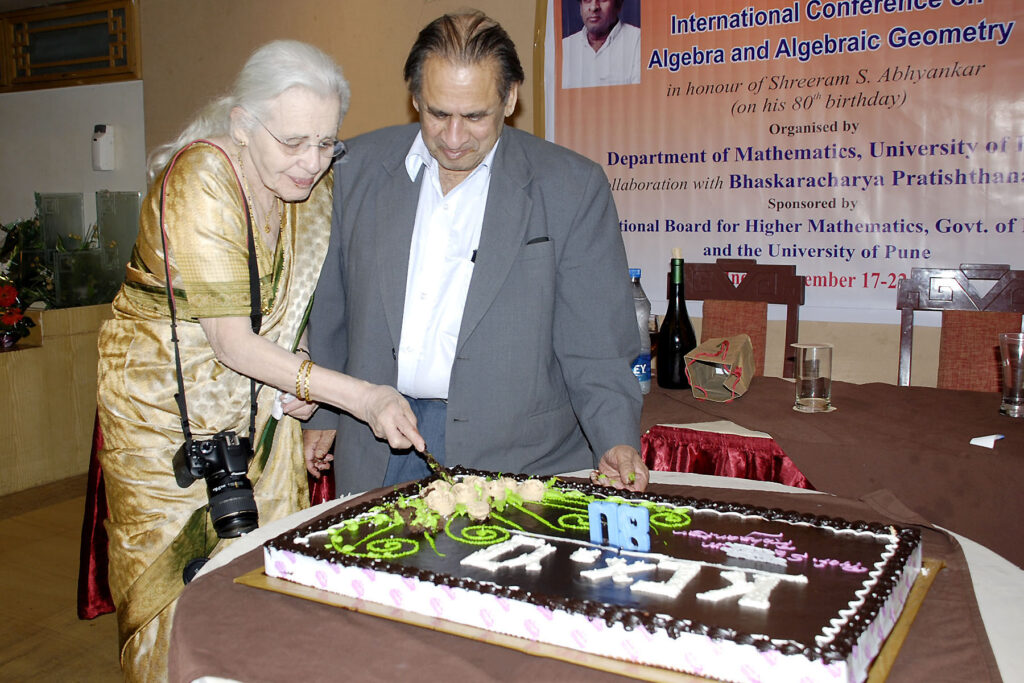 |
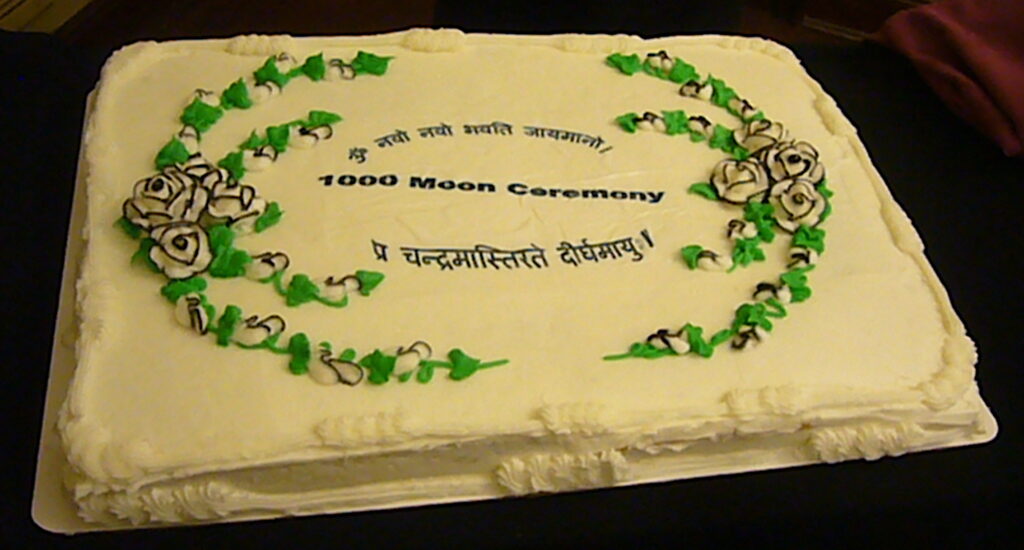 |
| Yvonne and Ram at the 80th birthday and Sahasra Chandra darśana celebrations of Abhyankar12 courtesy: Sudhir Ghorpade, Avinash Sathaye |
|
You have carefully studied many ancient texts and scriptures, including the famed Yoga-vāsiṣṭha, a dialogue between Lord Rama, and the sage Maharshi Vasiṣṭha. What message does this millennia-old text have for life in the modern day?
AS: Yes, Yoga-vāsiṣṭha is my favourite book and has been so for several years. It summarises many distinct ideas like faith, courage, being actively engaged even while facing a world that is continuously changing; and yet amidst all this change, there is an immutable entity which seems to govern it all. Or, does it really?
It is overflowing with many science fiction ideas like time travel, power of the thought over all obstacles, reverence for rituals, and also interspersed with examples that all rituals can be solely mentally executed if one so desires.
I never tire of reading its details on many incessant battles, natural or man-made disasters. It praises the worship of gods, but also states that gods don’t really give us anything; they only give us what we are capable of.
I could go on and on. In fact, I was holding regular Sunday sessions discussing this book over many years. Eventually my audience was no longer in town, though the Yoga-vāsiṣṭha was far from finished.
I am in communication with a Russian lady who has become a sanyasini and has been diligently translating it into English and Russian. She used to ask me questions about the meaning and usage of Sanskrit. In the beginning, she used to have 10-15 questions per sarga (chapter), but by now there are only one or two, and often zero!
I am sorry that I have not much to report on the other books: Upanishads, Purāṇas, Mahābhārata, Rāmāyaṇa and so on. I met the Upanishads quite early–in my high school years, and it continued through college and beyond. I read the other books mostly for amusement, but also as a help to understand how Hinduism has progressed (or regressed) during history.
However, I have never gotten really interested in Sanskrit poetry, and I don’t know why. My wife Shashi had more affection for Sanskrit poetry, but not as much for other parts of Sanskrit.
Between the competing, and sometimes even conflicting influences of rigour and intuition, what has personally served you better? Or is it better to adopt a judicious mix of the two?
AS: I don’t think these two processes are ever completely separated. However, intuition is what you use while creating new mathematics, but rigour is what you should practice when publishing. This still should not stop you from expressing your intuition while publishing. Often, the reader reads the proofs to verify them, if he cannot see the central argument himself. The comments following the proofs (or even at the beginning) are the most useful part for the reader.
What other interests keep you engaged presently?
AS: Well, I intend to learn Indian astronomy and compare it with current or old astronomy from elsewhere. I also want to study more Indian mathematics in its original form.
I still have not given up hope for the Jacobian problem, and I continue to think about it, and on other problems of interest from affine algebraic geometry. Of course, the affine geometry there does need help from projective geometry (or other extensions of it).
Dear Professor Sathaye, it was wonderful talking to you about your work and eclectic research interests. We wish you the very best in all your future endeavours. Thank you!
Acknowledgement: It is a pleasure to express our deep gratitude to Paul Eakin and Sudhir Ghorpade, acknowledging their immense help in the process of curating questions, answers, and also with some of the photos. \blacksquare
Footnotes
- A celebrated Soviet mathematician known for his fundamental work in topology, who lost his eyesight completely due to an unsuccessful eye surgery after a primus stove explosion when he was 14. ↩
- For example, an algebraic curve in the Euclidean plane is the set of the points whose coordinates are the solutions of a polynomial p(x,y) in two real variables; that is, the solutions of the equation p(x,y)=0. As an illustration, the solutions of the polynomial equation x^2+y^2-1=0 is the circle of unit radius in the Euclidean plane. A curve in 3-space, or more generally in n-space, is a one dimensional geometric configuration defined by the vanishing of n-1 polynomials in n variables. A quick example is the x-axis in 3-space, which is described by two polynomial equations y=0 and z=0. ↩
- T. T. Moh. On the Jacobian conjecture and the configurations of roots, J. Reine Angew. Math. 340 (1983) 140-212. ↩
- T. T. Moh, Jacobian conjecture, In Algebra and geometry (Taipei, 1995), volume 2 of Lect. Algebra Geom., pages 103-116. Int. Press, Cambridge, MA, 1998. ↩
- O.H. Keller, Ganze cremona-transformationen, Monats. Math. Physik, 47 (1939) 299–306. ↩
- W. Engel, Ein satz über ganze cremona transfirmationen der ebens. Math. Ann., 130 (1955) 11–19. ↩
- Abhyankar, Shreeram S., Some remarks on the Jacobian question. With notes by Marius van der Put and William Heinzer; Updated by Avinash Sathaye, Proc. Indian Acad. Sci. Math. Sci. 104 (1994), 515–542. ↩
- The Jacobian Conjecture is problem 16 in Steven Smale’s list of 18 problems for the 21st Century. In presenting his list of problems, Smale renewed the David Hilbert legacy of highlighting a list of important unsolved problems, at the crack of the dawn of a new century. ↩
- An idempotent element, or simply an idempotent, in a ring is an element a such that a^2 = a; for example 0 and 1 are idempotents under multiplication. ↩
- His son A.K. Ramanujan is a well-known literary personality. ↩
- Nyāya is one of the six orthodox schools of Indian philosophy. It primarily deals with pramāṇas, the means to validate knowledge. Coupled with its twin-system Vaiśeṣika, it forms the foundation of Indian logic. A collection of Gautama’s sūtras or aphorisms is considered the foundational text of this system. ↩
- Between 80 and 81, one is supposed to have sighted 1000 fullmoons. ↩
